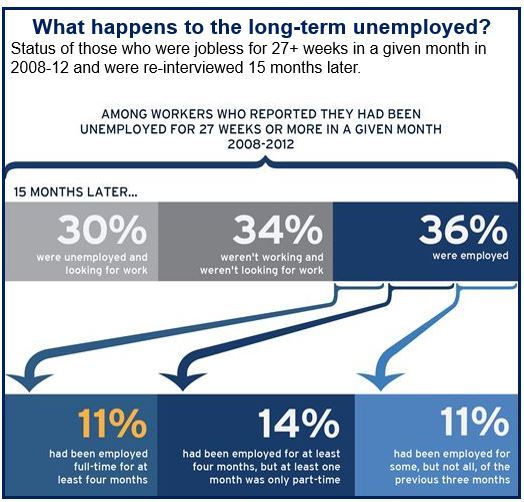Only 11% of the US long term unemployed manage to regain meaningful sustainable jobs, while the rest tend to remain pretty much jobless for the rest of their lives, says a new report published by the Brookings Institution and written by Alan B. Krueger, David Cho and Judd Cramer of Princeton University.
Real wage growth and inflation are much more closely predicted by short-term unemployment than the US’ overall unemployment rate.
Krueger, a renowned labor market economist who led President Obama’s Council of Economic Advisers, says that even in good times the long term unemployed “are on the margins of the labor market, with diminished job prospects and high labor force withdrawal rates, and as a result they exert little pressure on wage growth or inflation.”
In the study titled – Are the Long-Term Unemployed on the Margins of the Labor Market? – the authors found that for the majority of US long term unemployed people, the clock for long term joblessness is not fully reset when they find a job. Many are often unemployed again soon after being reemployed, “only 11% of those were long term unemployed in a given month return to steady, full-time employment a year later.”
US long term unemployment is a relatively new problem
Since the great recession, long term unemployment continues to be a persistent problem; a relatively new issue for the United States compared to Europe.
Even after four years of decline, the proportion of unemployed people who have been jobless for at least six months is still greater than the figures reached in the previous peak in 1981-1982, and is by far higher than the average in the last recovery.
However, short-term unemployment rates are similar to those registered in the last recovery. Consequently, overall unemployment remains high because of the high number of long term jobless people.
Long term joblessness is fairly evenly spread across all sectors of the economy, with those previously working in sales and services (36%) and blue collar workers (28%) hardest hit, the authors found.
Surprisingly, the majority of US long term unemployed people who do find jobs tend to do so in the same set of occupations and industries from which they were fired.
According to Krueger and team, the steep rise in the number of long term unemployed people in 2009-2013 is mainly due to the collapse in job vacancies together with a drop in labor force withdrawal rates, as well as the overall increase in the unemployment rate.
(Source: Brookings Institution)
Figures will return to normal when the long term unemployed exit labor force
The researchers demonstrated that the historically slower rate of reemployment among long term unemployed people in America can account for the shift in the relationship between the jobless figures and job vacancies.
“The unemployment-vacancy relationship will return to its original position as the long-term unemployed continue to exit the labor force,” they wrote.
The US long term unemployed find it hard to get jobs no matter where they are, even in parts of the country were unemployment is relatively low, such as Wyoming, Virginia, Vermont, Utah, S. Dakota, N. Dakota, New Hampshire, Nebraska, Montana, Minnesota, Kansas, Iowa and Hawaii – these states’ average unemployment rate is 4.4% compared to 7% elsewhere.
Long term unemployment will be an enduring problem
Long term unemployment increased rapidly in those 14 states with low rates of joblessness during the Great Recession, reaching 4.5 times their historical average. This suggests that long term joblessness will be a problem for a while, even after the overall unemployment rate returns to normal.
According to previous studies, the amount of time a long term unemployed person spends looking for work is inversely related to how long they have been unemployed – the longer they are jobless the less time they spend seeking work.
After comparing people with jobs with unemployed individuals, the authors found that unemployed people:
- tend to be younger
- are much less likely to be married
- are less likely to have a degree
When comparing long- and short-term unemployed people, the differences are much smaller than when compared to people in work. A high percentage of long term jobless individuals are 50+ years old in the US compared to the short term unemployed. Forty-four percent of long-term unemployed individuals have never been married, while almost 20% are either widowed, separated or divorced.
Ten percent of the employed population in the US consist of African Americans, compared to 22% of the long term jobless.
In many cases the long term unemployed are an unfortunate subset of the short term unemployed.
US long term unemployed compared to other countries
How does the US compare to other developed nations?
Italy – while 1 in 4 workers are aged between 15 and 34, nearly half of the long term jobless in Italy are within this age group. Just 15% of long term unemployed Italian workers are aged 50+ years, more than double the proportion in the US.
Fifty-six percent of Italian long term jobless workers have less than a high school education, compared to just 18% in the US. The authors wrote “These differences suggest that long-term unemployment in the U.S. reflects a different phenomenon than it does in countries that have had persistently high long-term unemployment.”
Sweden – after its severe financial crisis about twenty years ago, the proportion of long term unemployed in Sweden increased from 20% to 50%, and then gradually dropped to its pre-crisis levels, before rising again during the Great Recession.
Canada – long term unemployed people in Canada historically make up a higher proportion of total unemployment compared to the US. However, the share of long term unemployed individuals declined from the early 1990s to the Great Recession, and is currently nearly half the US share.
